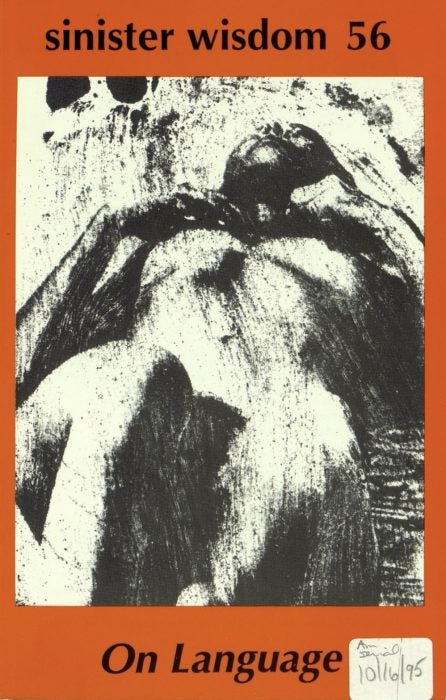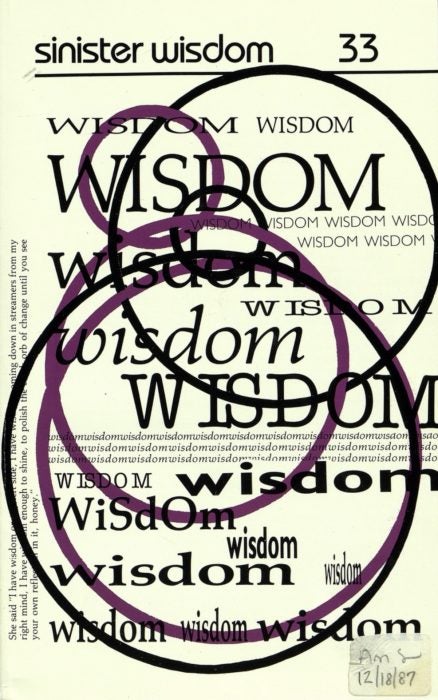The names of the journals in the Reveal Digital LGBTQ collection on JSTOR are…funny and earnest and vaguely, well, sinister…just like the people who made them. Big Mama Rag, Lavender Woman, Hard Labor, Dyke & Gorgons. Oh my heavens, I love them all! Full disclosure: I used to work on one of them. So you see, these are kind of my people and I get a little squee talking about them. I think Julie Enszer—editor of Sinister Wisdom—knows that, but we pretended to have a regular conversation about the lesbian-feminist press of the 1960s, 70s, 80s, and 90s. Because just like this collection and these journals, we love our people, but we’ve got our serious, intellectual, political side.
Enszer is a scholar and poet. She has an MFA and PhD from the University of Maryland, where she studied lesbian history and lesbian print culture. Her book manuscript A Fine Bind: Lesbian-Feminist Publishing from 1969 through 2009 “considers the theoretical and political formations of lesbian-feminism, separatism, and cultural feminism.”
Here’s an edited version of our chat.
Catherine Halley: I thought I could start by asking you to talk a little bit about Sinister Wisdom, where you are the editor. How long has it been around?
Julie Enszer: Sinister Wisdom started publishing in 1976. The founding editors Catherine Nicholson and Harriet Desmoines talk about starting it out of sadness when Amazon Quarterly ceased to publish. But I think they also started it at a moment when there were so many vibrant feminist and lesbian publications that they wanted to be in conversation with. Lots of people who were printing and publishing a variety of work that was prodding feminists and lesbians along in their thinking and their understanding of the world.
Tell me a little bit about your tenure there, and how things have changed since you started.
Sinister Wisdom really has been publishing continuously since 1976. The editor spot has been passed on and handed over to a variety of people [including Michelle Cliff and Adrienne Rich] in the years since then. I became the editor in 2010, so I’ve been doing it for 10 years now. I say that I was the very last person, that every other lesbian on the planet who might have become the editor said no, and then they came to me and I said, “Alright.” Partially I say that because when I became the editor, and for the first couple of years I edited it with Merry Gangemi, it was one of those generational transition moments without a lot of attention or thinking about what that transition meant.
What do you mean by a “generational transition moment?” I think I know, but I don’t want to make an assumption.
There are nuances and generational differences among the editors who edited the journal before I did, but by and large, most of them came up and came out in the lesbian feminist formations of the 1970s, 1980s, and the early part of the 1990s. So their sense and conception of feminism and lesbian feminism has some shared touch points, some shared ideas. Which is not to homogenize the work that those editors did. Each of them published very different types of work and had very different concerns that they brought to the journal and that the journal worked through. But I was born in 1970. I was very aware of lesbian feminism and the different types of consciousness that shaped women who were slightly older than I, but I really cut my teeth as an activist and as a person in a different formation that was really gay and lesbian.
I came out in 1987, but when I started working after college in 1990, it was just a different political landscape. The conversations that animated my years of activism were around inclusion of bisexual women, inclusion of trans issues, conversations around gay and lesbian marriage, and a formation that really was gay and lesbian more than lesbian feminist. So that’s what I mean by a generational transition—that I came out with a different political mindset and with a different cohort of people. I do think right now as younger people participate in the journal—I work with undergraduate and graduate student interns or people volunteering on the magazine who are in their 20s—they also bring a different generational sensibility than I have.
That really was one of my goals with the journal, to help us all think about how a lesbian journal could speak across generations and speak to people at different historic moments.
So do you think that the role of the publications has shifted or changed over the years?
Yes. Some things have stayed the same for the journal. It’s independent. It’s not connected to any academic institution. Now it’s a 501(c)(3) nonprofit organization; and it’s sustained by readers and subscribers. From the very first issue that Catherine and Harriett sent out, they said, “If you send us a couple bucks with a subscription, we’ll keep publishing until we run out of money.” That has very much been how the journal has operated. It’s been supported by subscribers and by women and lesbians in the community.
Those are some of the things that are consistent. I think it’s very much a changing journal based on what lesbian readers are looking for, what community is out there receiving it. All of those things, I think, make the journal dynamic.
It seems like the changing media landscape, particularly the move online, has changed the landscape for the alternative LGBTQ press.
Oh yeah. In some ways I kind of feel like Sinister Wisdom was a bit of an outlier. Even comparing us to Lesbian Connection. Now you can get your subscription to Lesbian Connection as a PDF, and they really have the capacity to manage that, which I admire enormously. They have an active Facebook page where they get some of the content that they publish. Lesbian Connection was this community bulletin board before the idea of an electronic bulletin board even existed, where all of the content is generated from readers and reader letters.
They’ve done a great job integrating their print journal and their online iterations. Sinister Wisdom has a very static, boring website. We really put the time and energy into the print journal. Most of the things we’ve tried online haven’t been hugely successful, but we keep trying!
What is the readership like now, and how has the readership changed over the years?
Right now Sinister Wisdom has about 1,000 subscribers, and I think that’s pretty consistent with where the journal had between 1970 and maybe 1985 or 1986. It grew a bit when the journal was under Elana Dykewomon’s editorship, and [based] in the Bay Area. I think for a while they had over 2,000, maybe 2,500 subscribers. The archives are not great on that question though. But we benchmark pretty well with what lesbian feminist and other feminist journals, particularly literary journals find to be a pretty good subscription number.
I was talking to one of the founders of Conditions magazine, which I think is also in the collection on JSTOR. She was recalling that in the late 70s they had about 1,000 subscribers. That’s pretty similar to what I’ve seen in their records too. So in one way, it seems to me like that’s the audience size that exists for these kinds of feminist literary journals. It’s not the same 1,000 women who were reading in the 1970s who are reading today. Our subscribers kind of cross all age groups, all races of women, and it’s an eclectic group of people who read Sinister Wisdom, some of whom always tell me all of their thoughts and opinions about the journal every time it publishes. Some who only tell me when we get things wrong, when we’ve made mistakes. But it’s a very engaged, lively group of subscribers, I would say.
Traditionally, how did people get ahold of the publications?
Well, I think one of the things for Sinister Wisdom, and particularly at times when they had bigger distribution was that there was a broad and vibrant network of places where people could purchase copies of the journal, particularly the feminist bookstores. At the high water mark, there were nearly 110 feminist bookstores located throughout the United States, and many women went to feminist bookstores to buy copies of feminist and lesbian journals that were being published. So that was something that really increased journals’ readership.
Now I distribute the magazine through about a dozen retail outlets, and we still have a handful of really vibrant, wonderful feminist LGBTQ bookstores. But it’s a very different landscape than, say, in 1990.
We do have the pass-along readership. I think of it as a uniquely feminist thing. Lots of people feel ownership of the journal and feel like a subscriber even if they don’t appear on our subscriber list in any way.
Right. It seems to me like the communities that surround Sinister Wisdom or some of the other lesbian feminist publications are so different than the communities that surround other more mainstream publications. Could you talk a little bit about that sense of community or how the journals create a sense of community?
I most often think about the different types of community that journals bring into being as differences within different feminist registers. Some people would describe Sinister Wisdom as being more of an intuitive journal. People have described it as more essentialist, invested in a particular view of women and women’s power and women’s authority, than say the journal Conditions, which I mentioned previously, which people thought of as having a much more materialist feminist analysis. Or compared to a journal like Azalea, which was a black lesbian journal published out of New York between 1977 and 1983. So there are the different feminist audiences, but you asked me to compare the audiences of feminist journals compared to other mainstream journals.
Part of it is the ethos of what started feminist journals, and women’s sense of wanting to take authority and learn how to produce things in collective ways, learn sets of new skills related to editing, to publishing, to printing. I think that was a big driver for a lot of the creation of journals as a way to really take power from the mainstream and elevate feminist voices. So that impulse to create the journal also draws around it a group of people who feel committed to the journal they’re publishing, who feel protective of it, and feel [that it creates] a sense of themselves.
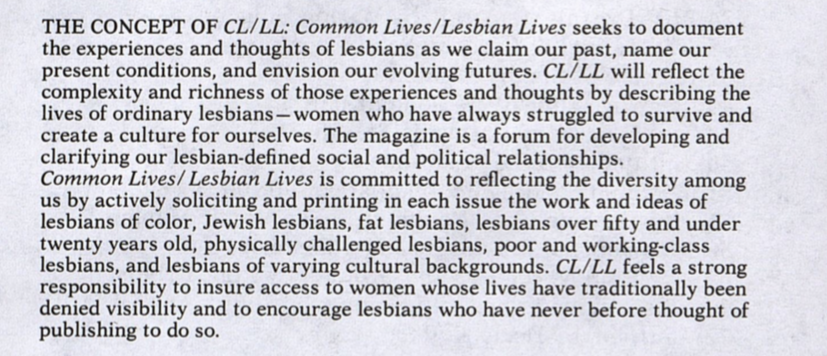
They want the journal to reflect back their sense of identity, who they are, and what their community is. Which is I think is very different than say literary journals that want to speak to a broader sensibility of the world. Places like The Georgia Review or Ploughshares, where their goal is to publish the best literary writing that exists.
In what way were these publications revolutionary?
One question is: how were they revolutionary in their past, because I do think that many of the feminist journals helped usher in a new sensibility for feminists and for women, and not just in literary spheres but also more broadly politically. The revolutionary vision of feminism was to create a more just world and to create more opportunities for women to have their lives reflected in the world, and to have access to the full world.
I never want to dismiss that revolutionary vision. While we still have ways to go to achieve aspects of it, there were other parts of it that have been achieved and our lives have been profoundly transformed. Part of that transformation came through the printing and publishing activities that feminists engaged in in the 70s and 80s, which continue today. So that’s one piece of it, and then the question is, and I grappled a lot with this when I became editor of Sinister Wisdom, is there still an ongoing revolutionary aspect of the work in publishing a lesbian journal, or has the revolutionary, transformative time ended?
I think that raises the questions: How does a journal continue to have relevance and meaning to an audience that exists in the world today? And how does a journal continue to galvanize people to both define meaning in their own life, but also to sort of think of different ways that transformation can come about through this very old activity and slow activity of publishing?
I’m working on the issue that we’ll publish in the fall, and I’ll spend most of my summer working on the issue that we’ll publish next year. So while our country is literally burning, I’m doing an activity that will reflect the experiences that we’re having this summer, but come out in a much slower way. It raises some of these tensions within publishing and within print of how you express the passions of the moment and the revolutionary zeal of a moment while recognizing the slow timeline that [print] publishing brings.
Weekly Newsletter
Obviously I give time to this project, so I think that there is revolutionary currency that’s a part of it, but the revolution I think comes about more slowly in print and is really about creating visions and connections through the page that people bring out into their work in the world.
As I look at the Independent Voices collection and the LGBTQ collection, in particular at the covers, you can see some of that revolutionary zeal. Some of these publications are 30 years old or 40 years old, but they still seem radical.
Yes. Part of it is the sort of palpable power of the moment when people were publishing it, and the other part of it is that even when we feel certain revolutionary outcomes have been achieved, protecting them continues to be important and continuing to invest in the vision and in the change is one of the things that makes issues return and continue to be relevant to new readers.
Absolutely. That’s why the project of preserving them and protecting the history, digitizing these journals becomes so important, right? Speaking of preserving history, are there any other journals that you feel like you want to call out?
I think that the publishing that came out of the 50s and 60s—One Magazine for instance—is really interesting and worth revisiting. I think sometimes we fall into these historical narratives thinking the 70s were the revolutionary period. We have ideas about what it meant to be gay or lesbian in the mid-century of the United States. I think those ideas are only a partial picture of what was happening.
And then, of course, there are really influential and important Black lesbian periodicals that have not been digitized. One is Azalea: A Magazine by Third World Lesbians that I mentioned earlier, and that was New York-based. Then there was Onyx: The Black Lesbian Newsletter, based in San Francisco that has not been digitized and the journal, I think it was out of Los Angeles, BLK, has also not been digitized. There’s a lot to be learned about African American lesbian, gay, bi, and trans issues in the United States from those journals.
When you dive into these periodical collections [that are digitized], you see the way some were multiracial editorial collectives that came together to publish journals that reflected their vision of feminism, and also the ways that even all-white journal editors were reaching out and talking to different groups of women and women writers in order to craft a different vision of feminism that was not monocultural. Lesbian Connection, Common Lives/Lesbian Lives, Conditions, many of these journals really were crucial publishing places for some really beloved writers of color that emerged out of the women’s liberation movement, including Audre Lorde, Sapphire, Pat Parker, Gloria Anzaldúa, Barbara Smith, Chrystos. And, of course, there was Dorothy Allison whose work engaged people in thinking about the different class experiences in the United States. Dorothy published in a number of the feminist periodicals. There’s a whole sort of constellation of African American and Latinx and Indigenous writers who were publishing work, were in conversation. Now we only think about Audre Lorde, but Audre Lorde was part of a group of writers working in different ways at that time.
The Editors Recommend These Important Issues from the Collection:
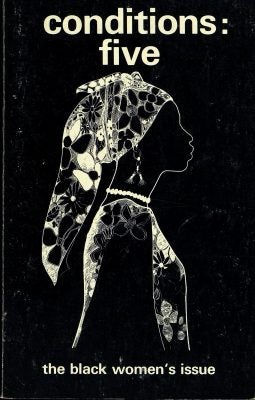
Conditions: Five, “Black Women’s Issue.”, 1979: co-edited by Lorraine Bethel and Barbara Smith. Contributors include Cheryl Clarke, Audre Lorde, Pat Parker, Beverly Smith, and many others.
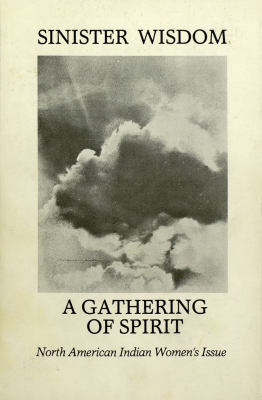
Sinister Wisdom 22/23, “A Gathering of Spirit: North American Indian Women’s Issue.”, 1983: edited by Beth Brant (Degonwadonti). Contributors include Joy Harjo, Chyrstos, Linda Hogan, Carol Lee Sanchez, and many others.



